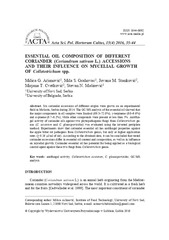| dc.creator | Aćimović, Milica | |
| dc.creator | Grahovac, Mila | |
| dc.creator | Stanković, Jovana | |
| dc.creator | Cvetković, Mirjana | |
| dc.creator | Maširević, Stevan | |
| dc.date.accessioned | 2019-11-03T10:41:17Z | |
| dc.date.available | 2019-11-03T10:41:17Z | |
| dc.date.issued | 2016 | |
| dc.identifier.issn | 1644-0692 | |
| dc.identifier.uri | http://www.hortorumcultus.actapol.net/volume15/issue4/abstract-35.html | |
| dc.identifier.uri | http://www.hortorumcultus.actapol.net/tom15/zeszyt4/abstrakt-35.html | |
| dc.identifier.uri | https://cer.ihtm.bg.ac.rs/handle/123456789/3196 | |
| dc.description.abstract | Six coriander accessions of different origins were grown on an experimental field in Mošorin, Serbia during 2014. The GC/MS analysis of the essential oil showed that the major components in all samples were linalool (69.3–72.0%), γ-terpinene (6.0–9.6%) and α-pinene (6.7–8.2%), while other compounds were present at less than 5%. Antifungal activity of coriander oils against two phytopathogenic fungi from Colletotrichum genus (C. acutatum and C. gloeosporioides) was evaluated using the inverted petriplate method. Experiments show that coriander essential oil has antifungal properties against the apple bitter rot pathogens from Colletotrichum genus, but only at higher application rates (≥ 0.16 µl/ml of air). According to the obtained data, it can be concluded that tested coriander accessions differ in essential oil content and composition, as well as in influence on mycelial growth. Coriander essential oil has potential for being applied as a biological control agent against these two fungi from Colletotrichum genus. | en |
| dc.description.abstract | Sześć populacji kolendry różnego pochodzenia uprawiano na polu doświadczalnym w Mošorin w Serbii w 2014 roku. Analiza GC/MS olejku lotnego wykazała, że głównymi składnikami we wszystkich próbkach były linalol (69,3–72,0%), γ-terpinen (6,0–9,6%) oraz α-pinen (6,7–8,2%), natomiast inne składniki były obecne w ilości mniejszej niż 5%. Przeciwgrzybicze działanie olejków kolendry względem dwóch grzybów fitopatogenicznych z gatunku Colletotrichum (C. acutatum i C. gloeosporioides) oceniono za pomocą metody odwróconych szalek Petriego. Doświadczenia wykazały, że olejek eteryczny kolendry ma właściwości antygrzybicze względem patogenów gorzkiej zgnilizny jabłoni pochodzących z gatunku Colletotrichum, ale tylko przy większych dawkach aplikacji (≥ 0,16 µl/ml powietrza). Na podstawie uzyskanych danych można wyciągnąć wniosek, że badane populacje kolendry różnią się zawartością olejku eterycznego oraz wpływem na wzrost grzybni. Olejek eteryczny kolendry posiada potencjał jako środek ograniczający dwa grzyby z gatunku Colletotrichum. | pl |
| dc.publisher | Wydawnictwo Uniwersytetu Przyrodniczego w Lublinie | |
| dc.relation | info:eu-repo/grantAgreement/MESTD/Integrated and Interdisciplinary Research (IIR or III)/46008/RS// | |
| dc.relation | Provincial Secretariat for science and technological development, Autonomous Province of Vojvodina (114-451-2373/2014-03) | |
| dc.rights | openAccess | |
| dc.rights.uri | https://creativecommons.org/licenses/by-nc-nd/4.0/ | |
| dc.source | Acta Sci. Pol.Hortorum Cultus | |
| dc.subject | antifungal activity | |
| dc.subject | Colletotrichum acutatum | |
| dc.subject | C. gloeosporioides | |
| dc.subject | GC/MS analysis | |
| dc.title | Essential oil composition of different coriander (coriandrum sativum l.) accessions and their influence on mycelial growth of colletotrichum spp. | en |
| dc.type | article | |
| dc.rights.license | BY-NC-ND | |
| dcterms.abstract | Граховац, Мила; Цветковић, Мирјана; Станковић, Јована; Aћимовић, Милица; Маширевић, Стеван; | |
| dc.rights.holder | Wydawnictwo Uniwersytetu Przyrodniczego w Lublinie | |
| dc.citation.volume | 15 | |
| dc.citation.issue | 4 | |
| dc.citation.spage | 35 | |
| dc.citation.epage | 44 | |
| dc.citation.rank | M22 | |
| dc.identifier.rcub | https://hdl.handle.net/21.15107/rcub_cer_3196 | |
| dc.identifier.fulltext | https://cer.ihtm.bg.ac.rs/bitstream/id/15355/15_4_35.pdf | |
| dc.type.version | publishedVersion | |


